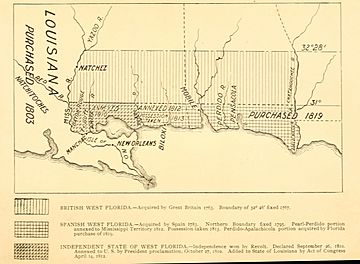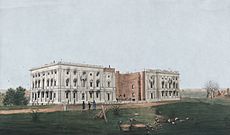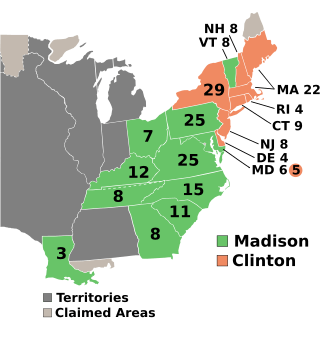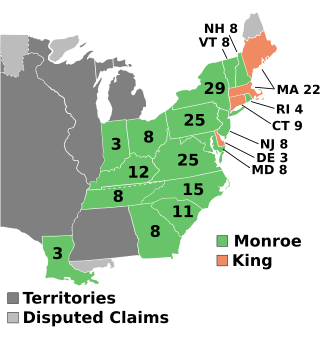Presidency of James Madison facts for kids
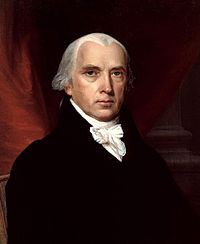 |
|
Quick facts for kids
Presidency of James Madison
|
|
|---|---|
| March 4, 1809 – March 4, 1817 | |
| Cabinet | See list |
| Party | Democratic-Republican |
| Election |
|
| Seat | White House |
|
← Thomas Jefferson • James Monroe →
|
|
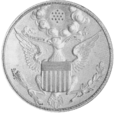 |
|
| Dorsett seal | |
The presidency of James Madison began on March 4, 1809. He became the fourth U.S. President after winning the 1808 election. He was re-elected four years later in 1812.
Madison's time as president was mostly shaped by the Napoleonic Wars happening in Europe. At first, American businesses did well from these wars. But soon, both Britain and France started attacking American ships. This was to stop trade with their enemies.
Because Britain kept attacking American ships and forcing American sailors into their navy (a practice called impressment), the United States declared war. This started the War of 1812. The war was tough for the U.S. because it didn't have a strong army or a good financial system. In 1814, British troops even burned the White House and the Capitol in Washington, D.C.
However, the U.S. won some important naval battles. They also defeated Native American groups allied with the British in the West. The war ended with the Treaty of Ghent. Neither side gained much land. But because the treaty was signed right after a big American victory at the Battle of New Orleans, many Americans felt they had won. Madison's popularity grew a lot. The Federalist Party, which had been against the war, lost much of its power after this.
Madison wanted to continue the idea of limited government, like his friend Thomas Jefferson. But after the war, Madison supported higher taxes on imports (called tariffs). He also wanted more money for the military and a new national bank, the Second Bank of the United States. Even with some disagreement, many of Madison's ideas after the war became law. He left office very popular. His chosen successor, James Monroe, easily won the next election.
Historians often rank Madison as an above-average president.
Contents
Becoming President
The Election of 1808
As Thomas Jefferson finished his second term, James Madison became the top choice for president from the Democratic-Republican Party. Some members of his own party, like John Randolph of Roanoke, didn't support him. Another group wanted George Clinton, the current Vice President, to be president.
But Madison won the party's nomination. The opposing Federalist Party was not very strong outside of New England. So, Madison easily defeated their candidate, Charles Cotesworth Pinckney, in the general election. Madison won 122 electoral votes compared to Pinckney's 47. George Clinton was re-elected as Vice President.
The main topic of this election was the Embargo Act of 1807. This law had stopped all trade from U.S. ports. It hurt merchants and businesses, especially in New England. This economic trouble made the Federalist Party stronger for a short time.
Leading the Country
Madison's Cabinet
| The Madison Cabinet | ||
|---|---|---|
| Office | Name | Term |
| President | James Madison | 1809–1817 |
| Vice President | George Clinton | 1809–1812 |
| none | 1812–1813 | |
| Elbridge Gerry | 1813–1814 | |
| none | 1814–1817 | |
| Secretary of State | Robert Smith | 1809–1811 |
| James Monroe | 1811–1817 | |
| Secretary of Treasury | Albert Gallatin | 1809–1814 |
| George W. Campbell | 1814 | |
| Alexander J. Dallas | 1814–1816 | |
| William H. Crawford | 1816–1817 | |
| Secretary of War | William Eustis | 1809–1813 |
| John Armstrong Jr. | 1813–1814 | |
| James Monroe | 1814–1815 | |
| William H. Crawford | 1815–1816 | |
| George Graham (acting) | 1816–1817 | |
| Attorney General | Caesar Augustus Rodney | 1809–1811 |
| William Pinkney | 1811–1814 | |
| Richard Rush | 1814–1817 | |
| Secretary of the Navy | Paul Hamilton | 1809–1813 |
| William Jones | 1813–1814 | |
| Benjamin Williams Crowninshield | 1815–1817 | |
When Madison became president, he faced challenges with his cabinet. His first choice for Secretary of State was rejected by Congress. He kept Albert Gallatin as Secretary of the Treasury. Gallatin was a very smart advisor to Madison.
Other early cabinet members were chosen more for political reasons than for their skills. Madison didn't always trust them. He often met only with Gallatin to discuss important matters.
In 1811, Madison replaced Secretary of State Robert Smith with James Monroe. Monroe became a very important person in Madison's government. During the War of 1812, Madison made more changes to his cabinet. By 1814, he finally had a team he could work well with.
Vice Presidents During Madison's Term
Two different people served as Vice President under Madison. George Clinton was Vice President from 1809 until he died in 1812. He was the first Vice President to die while in office. At that time, there was no rule to replace a Vice President who died. So, the position stayed empty.
After Madison won re-election in 1812, Elbridge Gerry became Vice President in 1813. He also died in office in 1814. This meant the Vice Presidency was empty again for the rest of Madison's second term. Madison is the only president to have two Vice Presidents die while in office.
Judicial Appointments
Madison appointed two judges to the Supreme Court. In 1810, after a judge passed away, Madison looked for a replacement. After a few tries, he chose Joseph Story, a young lawyer. Story was approved quickly and served on the court for many years.
Another opening came in 1811. Madison nominated Gabriel Duvall, who was also approved. Even though Jefferson and Madison hoped to reduce the influence of Chief Justice John Marshall, Madison's appointments did not change the court's overall ideas.
Key Policies Before the War
Economic Plans
Madison wanted to continue Jefferson's ideas of low taxes and reducing the national debt. A big issue was the First Bank of the United States. Its special permission to operate was ending in 1811.
Gallatin, Madison's Treasury Secretary, wanted to keep the bank. He thought it was important for the country's money system. But many Democratic-Republicans didn't like the bank. They saw it as favoring rich city people. Madison didn't take a strong side, and Congress let the bank's permission expire.
After this, many new state-run banks opened. These banks printed their own money, which became a big part of the U.S. money system. The federal government didn't print its own money back then.
Adding West Florida
Getting West Florida from Spain was a major goal for President Jefferson, and Madison continued this effort. Spain's control over its colonies was weak because of a war in Europe. Madison worried that Britain might take over West Florida. This would give Britain control of land both north (Canada) and south of the U.S.
In 1810, the people of West Florida, many of whom were American, declared their independence from Spain. They called it the Republic of West Florida. They asked Madison to send troops to protect them. Madison announced that the U.S. was taking control of the area. Spain later agreed to U.S. control of West Florida in a treaty in 1819.
The War of 1812
Why the War Started
Europe had been at war for many years. The U.S. had traded with both France and Britain. But in 1807, Britain announced rules that blocked trade with France. France then said it would attack American ships that visited British ports.
The biggest problem between Britain and the U.S. was the British practice of impressment. Britain was fighting a long, expensive war against France. Many British sailors were forced into their navy. Some of these sailors ran away and joined American merchant ships. Britain couldn't stand losing these sailors. So, they would stop American ships and force captured crewmen, even some who were American, to serve in the British navy. Americans were very angry about this.
Madison tried to get Britain to stop these attacks, but they refused. He was against war because it would mean more debt and taxes. However, Britain's actions continued to upset Americans.
Many Americans felt it was time for a "second war of independence" to show the world the U.S. was strong. A group of politicians called "war hawks," led by Henry Clay and John C. Calhoun, pushed for war. Many Americans, including Madison, believed the U.S. could easily capture Canada from Britain. This could be used as a bargaining chip or even kept.
On June 1, 1812, Madison asked Congress to declare war. Congress agreed, but there was strong opposition from the Federalist Party and in the Northeast, where businesses had suffered from trade restrictions.
Before the war, Jefferson and Madison had made the military smaller and closed the national bank. This made it harder for the U.S. to fight. The U.S. military was mostly made up of poorly trained local soldiers.
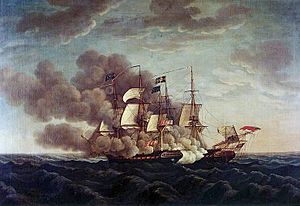
Fighting the War
Madison hoped the war would end quickly with the capture of Canada. But his hopes were soon dashed. State governors in the Northeast didn't cooperate. Their local soldiers often refused to leave their home states to fight. Many military leaders were not very good. The general at Detroit even surrendered to a smaller British force without a fight.
It was also hard to pay for the war. The national bank was closed, and bankers in New England refused to lend money. The government relied on taxes on imports, which were not enough.
Despite these problems, the U.S. had some successes. American privateers (private ships allowed to attack enemy ships) captured 1,800 British ships. On Lake Erie, the U.S. navy won a key battle. This victory helped cut off supplies to British forces in the West.
After the Battle of Lake Erie, General William Henry Harrison defeated British and Native American forces at the Battle of the Thames. The death of the Native American chief Tecumseh in this battle ended organized Native American resistance in the Northwest. In the South, General Andrew Jackson defeated the Muscogee (Creek) people at the Battle of Horseshoe Bend.
In 1814, after Napoleon was defeated in Europe, Britain sent more soldiers to North America. In August 1814, a large British force landed near Washington, D.C. American forces were defeated at the Battle of Bladensburg. President Madison himself briefly directed some artillery units in this battle. This is the only time a sitting U.S. President has led troops in battle.
After winning the battle, British forces set fire to federal buildings in Washington, D.C. First Lady Dolley Madison bravely saved important White House valuables and documents before the British burned the White House. The British then moved on to Baltimore, but they were stopped after the U.S. successfully defended Fort McHenry.
The British also tried to invade New York from Canada. But an American victory at the Battle of Plattsburgh in September 1814 stopped this plan.
Knowing the British might attack New Orleans next, Secretary of War James Monroe ordered General Jackson to prepare the city's defense. On January 8, 1815, Jackson's forces won a huge victory over the British at the Battle of New Orleans.
Just over a month later, Madison learned that a peace treaty had been signed in Europe. This was the Treaty of Ghent, and it officially ended the war. Neither side gained much land. To most Americans, it seemed like the victory at New Orleans had forced Britain to make peace. This idea made Madison very popular and helped Americans feel proud of their country. The U.S. was now seen as a stronger nation in the world.
After the War
The Federalist Party Fades
By 1809, the Federalist Party was losing power. Many Federalists even joined Madison's Republican Party. The War of 1812 was very unpopular in New England, where the Federalists were strongest. In December 1814, leaders from New England met at the Hartford Convention to discuss their complaints.
Some at the meeting wanted their states to leave the United States. But most did not go that far. They asked for several changes to the Constitution. However, they arrived in Washington, D.C., just as news of the Battle of New Orleans and the Treaty of Ghent arrived. Americans were celebrating a victory, and the Hartford Convention's requests were mostly ignored.
Because the Federalists had been against the war, and Americans felt they had won, the Hartford Convention hurt the party badly. After the War of 1812, the Federalist Party almost disappeared as a national political force.
New Economic Plans
After the war, Madison realized the country needed changes. He suggested bringing back a national bank. He also wanted to spend more money on the Army and Navy. He supported a tariff (a tax on imported goods) to protect American businesses from foreign competition.
Madison also said that internal improvements like roads and canals were important for the country's economy and unity. He even called for a change to the Constitution to allow federal spending on these projects. These ideas were a big shift for Madison, who had once favored smaller government.
Congress responded by passing important laws. The Tariff of 1816 was easily approved. It set high taxes on imported goods that could be made in the U.S. Congress also approved a new Second Bank of the United States. This bank was given permission to operate for 25 years. The U.S. government owned part of the bank and helped manage it.
Madison also approved federal money for the Cumberland Road. This road helped connect the country's eastern and western lands. It helped people move to new areas. However, in his last act as president, Madison vetoed a bill that would have paid for more roads and canals. He believed the Constitution did not give the federal government the power to spend money on such projects.
Fighting Pirates in North Africa
During the War of 1812, states along the Barbary Coast (in North Africa) increased their attacks on American ships. These states demanded money from countries that traded in the Mediterranean Sea.
After the War of 1812 ended, the U.S. could use its larger navy against these states. In March 1815, Congress declared war on Algiers. The U.S. sent its largest fleet ever to the Mediterranean Sea. After some defeats, Algiers agreed to a treaty. Other Barbary States, Tunis and Tripoli, also signed treaties. They agreed to release prisoners and stop demanding tribute payments.
Native American Policy
Madison believed the government should help Native Americans become farmers instead of hunters. He met with leaders from groups like the Muscogee (Creek) and Osage.
After his victory at the Battle of Horseshoe Bend, General Jackson forced the defeated Muscogee to sign the Treaty of Fort Jackson. This treaty made the Muscogee and the Cherokee (who had helped Jackson) give up 22 million acres of land in Alabama and Georgia. The British had promised to help their Native American allies, but they abandoned them. The U.S. then took stronger control of its western and southern borders.
New States
Two new states joined the United States while Madison was president:
Presidential Elections During Madison's Time
The Election of 1812
In May 1812, James Madison was easily chosen again as the Democratic-Republican candidate for president. However, a group from New York nominated DeWitt Clinton to run against Madison. Clinton was the nephew of the recently deceased Vice President, George Clinton.
This group hoped to unite people who were against the coming war, those angry with Madison, and Northerners tired of Southern control of the White House. The Federalist Party also supported Clinton.
To gain support in the Northeast, where the War of 1812 was unpopular, Madison chose Elbridge Gerry of Massachusetts as his running mate. Madison won re-election, though by a close margin. He received 128 electoral votes to Clinton's 89. This election was the last time the Federalist Party seriously challenged for the presidency.
The Election of 1816
For the 1816 election, Madison and Jefferson both supported James Monroe, who was Madison's Secretary of State. With their support, Monroe won the Democratic-Republican nomination. Daniel D. Tompkins of New York became Monroe's running mate.
Since the Federalist Party was collapsing, Monroe easily defeated the Federalist candidate, Rufus King.
How Historians See Madison
Even though Madison's presidency ended with a popular feeling of victory, historians have often been more critical. Much of the praise for Madison comes from his achievements before 1800.
Historians have criticized how Madison handled the War of 1812. Some say he was an "incapable President" who "mismanaged an unnecessary war." However, others praise his steady leadership during the war. They note that he avoided increasing the president's power too much. One person at the time said the war was fought "without one trial for treason."
Some historians say Madison allowed Congress to take too much power from the presidency. This meant the president had less control over important political decisions. Madison also struggled to get his choices for cabinet members approved by Congress at times.
Overall, historians have mixed views. Some say his presidency was "great" because of his accomplishments. Others say it was "weak and bumbling" because of his leadership failures.
Polls of historians and political scientists usually rank Madison as an above-average president. A 2018 poll ranked him as the twelfth best president. A 2017 poll ranked him seventeenth. However, a 2006 poll ranked his failure to prevent the War of 1812 as one of the worst mistakes by a sitting president.



